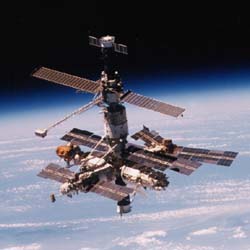
Picture from: http://nssdc.gsfc.nasa.gov |
|
| MIR |
|
A large and long-lived Russian space station, the first segment of which was launched in February 1986. Bigger than its predecessors, the Salyut series, and composed of several modules, Mir (“Peace”) was designed to house more cosmonauts on longer stays than the Salyuts could support.
The assembly of the 6 MIR modules delayed 10 years and only remained in operation for 5 years more (1986 to 2001).
After multiple faults, accidents and serious economic problems to maintain it in orbit, at early 2001 the RKA, the station operating institution, decided to de-orbit it on March of the same year. Finally the MIR broken pieces fell in the Pacific Ocean near New Zealand at the end of that month.
The 3D model that here is presented is a modest tribute to the services that offered this space station.
|
| MIR modules
Core (1986)
The core of Mir was the “base block” living quarters, equipped with six docking ports to which visiting spacecraft and additional modules could be attached.
Although the core module, closely resembled two previous Soviet space stations, Salyut-6 and Salyut-7, it was a major departure from the latter. Since most of the payload of the future station was expected to be placed on board "add-on" modules, the core itself was free from a huge instrument section filling most of the volume inside two previous orbital labs. Free space on Mir's core was used to fit two tiny but comfortable crewmember cabins, each featuring a window.
|
Kvant (1987)
A habitable module attached to Mir’s aft port for conducting research in astrophysics and supporting experiments in antiviral preparations and fractions. Kvant (“quantum”) was divided into a pressurized laboratory compartment and a nonpressurized equipment compartment. The laboratory compartment was further divided into an instrumentation area and a living area, separated by an interior partition. A pressurized transfer chamber connects the Passive Docking Unit with the laboratory chamber.
|
Kvant 2 (1989)
Kvant 2 carried an airlock for spacewalks, solar arrays, and life support equipment, and was based on the transport logistics spacecraft originally intended for the Almaz military space station program of the early 1970s. Its purpose was to provide biological research data, Earth observation data, and EVA capability. Kvant 2 added additional system capability to Mir. Kvant-2 includes additional life support system, drinking water, and oxygen provisions, motion control systems, and power distribution, as well as shower and washing facilities. Kvant-2 is divided into three pressurized compartments: instrumentation/cargo, science instrument, and airlock.
|
Kristall (1990)
One of Mir’s science modules. Berthed opposite Kvant 2 , Kristall (“crystal”) carried two stowable solar arrays, science and technology equipment, and a docking port equipped with a special androgynous docking mechanism designed to receive heavy (up to about 100-ton) spacecraft equipped with the same kind of docking unit. Kristall’s main aim was to develop biological and materials production technologies in microgravity. The androgynous unit was originally developed for the Russian Buran Shuttle program. Atlantis used the androgynous docking unit on Kristall during mission STS-71.
|
Spektr (1995)
Science module designed for Earth observations and berthed opposite Kvant 2. Spektr (“spectrum”) was badly damaged on Jun. 25, 1997, when Progress M-34, an unmanned supply vessel, crashed into it during tests of a new Progress guidance system. The module sustained a hole, lost pressure and electricity, and had to be shut down completely and sealed off from the remainder of the Mir complex. Its undamaged solar arrays were later reconnected to the station’s power system by exterior cables attached by two spacewalking cosmonauts on a later stay. The cosmonauts also installed a plate over the interior hatch to Spektr, during a unique “inside spacewalk.”
|
Priroda (1996)
A microgravity and remote sensing module that included equipment for American, French, and German experiments; its name means “nature.” Soon, after Priroda successfully reached orbit on Apr. 23, 1996, a failure in its electrical supply system halved the amount of power available onboard. Since it had no solar panels, the module had only one attempt to dock with Mir, before loosing all its power and maneuverability. Given the fact that several previous modules had to abort their initial docking attempts, ground controllers were extremely nervous about the situation. Fortunately, the Priroda docking went flawlessly on Apr. 26, 1996.
|
| Some MIR data |
|
|
|
| Name |
Year |
Length (m) |
Diameter (m) |
Mass (tons) |
| Kvant |
1987 |
5.8 |
4.2 |
11 |
| Kvant 2 |
1989 |
13.7 |
4.4 |
18.5 |
| Kristall |
1990 |
13.7 |
4.4 |
19.6 |
| Spectr |
1995 |
11.9 |
4.4 |
19.6 |
| Priroda |
1996 |
13 |
4.4 |
19.7 |
Information from: David Darling's encyclopedia |
|